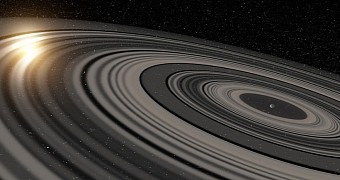A rather peculiar celestial body located at a distance of about 420 light-years away from us sports a freakishly massive ring system around it, scientists write in a new paper in the Astrophysical Journal.
The body in question is either a young ginormous planet or a brown dwarf, i.e. a cosmic object that is too large to be called a planet but that is not massive enough to sustain fusion reactions and qualify as a star.
Data at hand indicates that this celestial body, nicknamed J1407b, has a ring system comprising well over 30 rings and measuring almost 120 million kilometers (almost 75 million miles) across.
In fact, the ring system, discovered in 2012 and thoroughly studied these past few years, is so big that it eclipses light originating from the nearby young Sun-like star J1407, astronomers detail in the Astrophysical Journal.
Interestingly enough, this collection of rings that surrounds J1407b appears to sport several gaps in its makeup. Scientists believe that these holes are proof of the presence of moons hard at work clearing their orbits.
Just to put things into perspective, astronomers say that J1407b's ring system is about 200 times larger and heavier than that of Saturn, our neighbor towards the edge of the Solar System.
“If we could replace Saturn’s rings with the rings around J1407b, they would be easily visible at night and be many times larger than the full moon,” said astronomer Matthew Kenworthy with the Leiden Observatory in the Netherlands.

 14 DAY TRIAL //
14 DAY TRIAL //